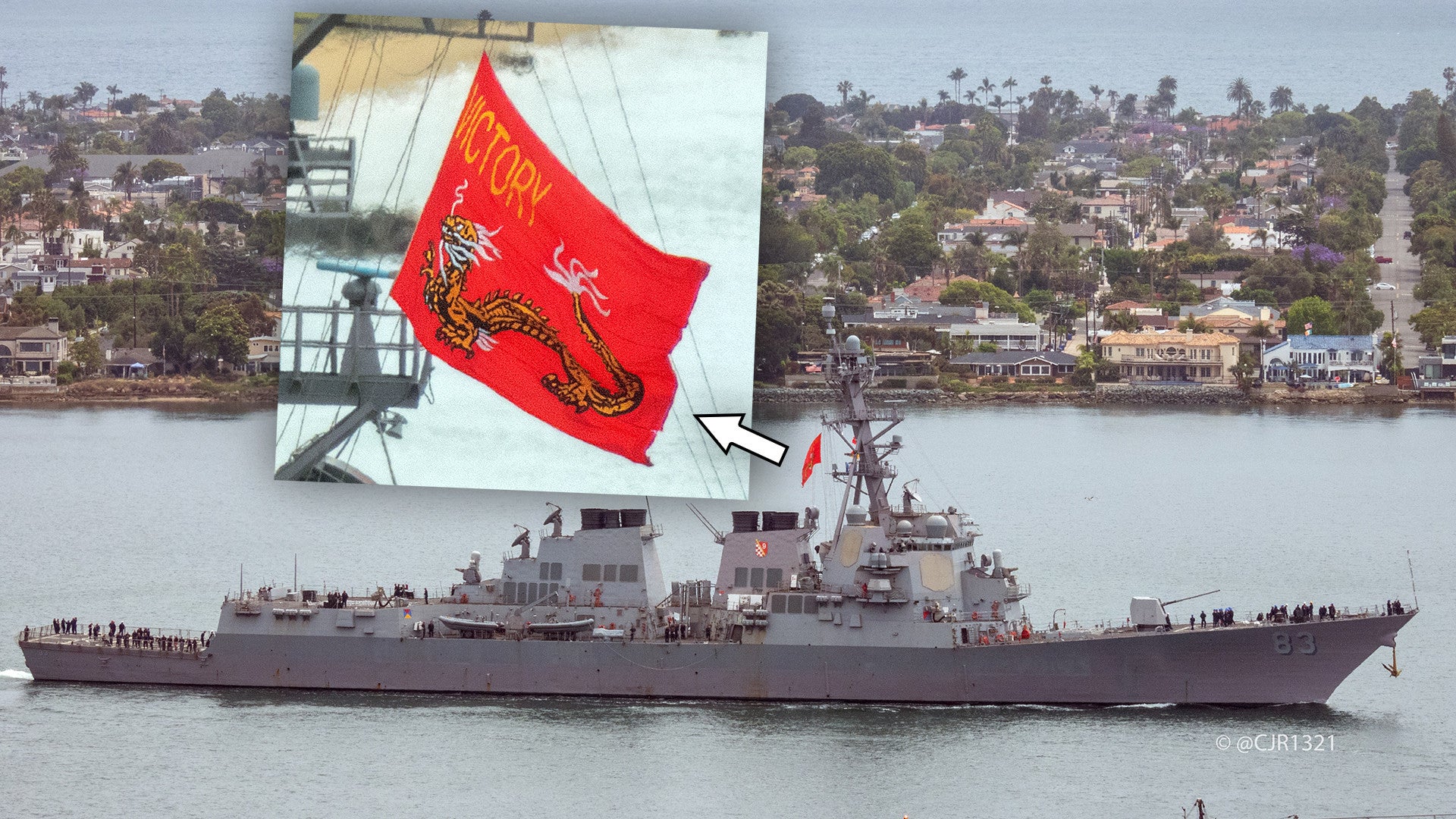We here at The War Zone are always on the lookout for notable and unique flags flying from U.S. Navy warships, which often have some very interesting history behind them. Yesterday, our Twitter contact @cjr1321 spotted the Arleigh Burke class destroyer USS Howard leaving San Diego flying a bright red flag emblazoned with an ornate East Asian-style dragon and the word “victory” in large gold-colored letters. @cjr1321’s images were subsequently posted on one of our favorite twitter accounts, @warshipcam. After close review, the flag appears to be based on parts of the ship’s coat of arms, which makes references to its namesake, Medal of Honor recipient U.S. Marine Corps First Sergeant Jimmie E. Howard, as well as a Wickes class destroyer of the same name that served during World War II.
The current USS Howard, also known by its hull number DDG-83, is a Flight IIA Arleigh Burke class destroyer homeported in San Diego and assigned to the Navy’s Pacific Fleet as part of Destroyer Squadron Nine. The destroyer was commissioned in 2001, becoming the fifth Flight IIA subvariant and the 33rd ship in the class, overall, to enter service.
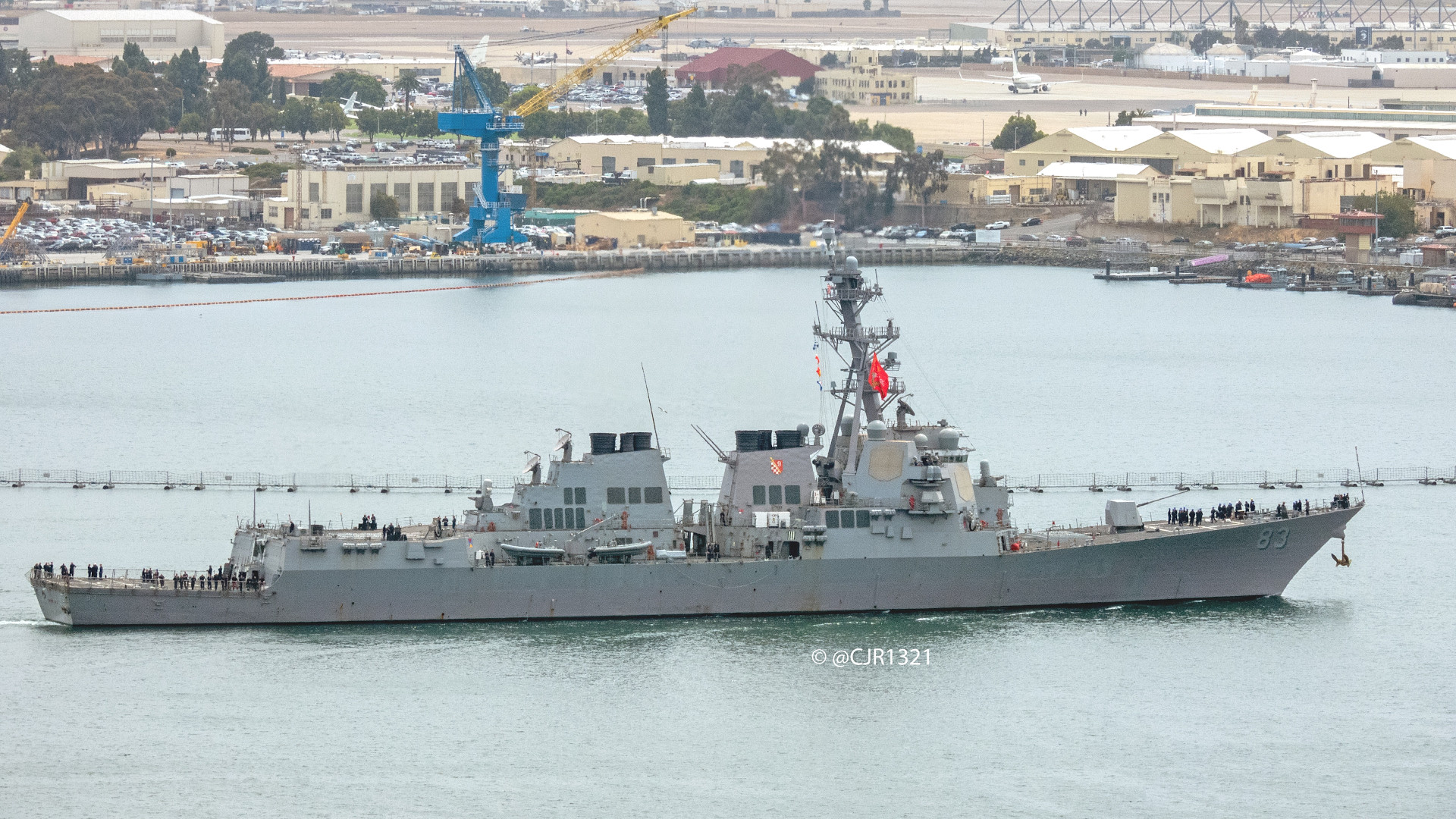

A dragon that is very similar to the one seen on the flag the ship was flying as it departed San Diego, as well as the word “victory,” also appears on Howard‘s official coat of arms. The word victory on the flag appears to simply reference the ship’s motto, which appears on a scroll in the coat of arms, and is “Ready for Victory.”
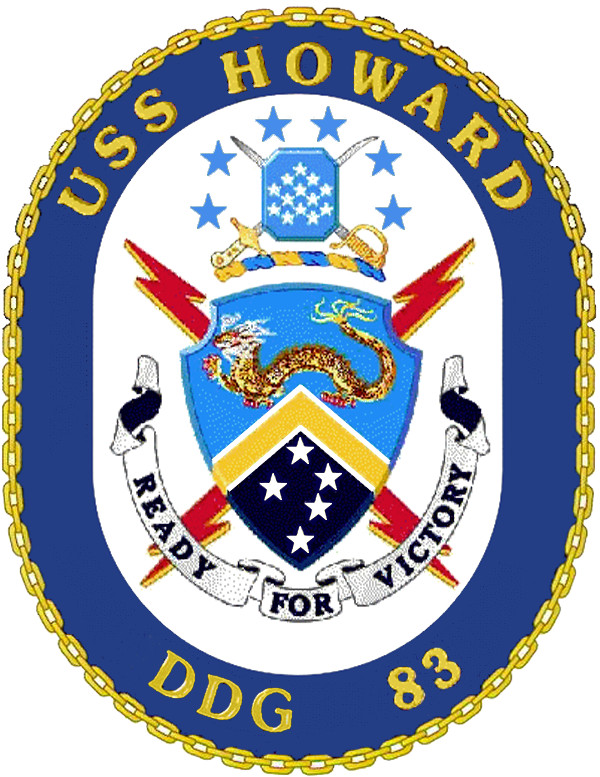
The meaning behind the dragon, which has become a symbol generally associated with the ship, is more involved. “The oriental dragon denotes service in the Pacific and the fighting spirit demonstrated by the platoon under the leadership of Gunnery Sergeant Howard,” according to an entry on the website of The Institute of Heraldry (TIOH), a U.S. Army-run organization that manages the design of heraldic devices and unit insignia across the services. That latter part refers to actions during the Vietnam War that led to Jimmie E. Howard being awarded the Medal of Honor.
Jimmie E. Howard joined the Marines in 1950. Two years later, he was sent to Korea to join the 1st Marine Regiment’s 4.2-inch mortar company as a forward observer. 1st Marines had been fighting on the Peninsula since 1950, taking part in the amphibious landings at Inchon and then in the grueling Chosin Reservoir Campaign.
Then-Corporal Howard was awarded a Silver Star, as well as for his actions between Aug. 12 and 15, 1952, where he helped call in 4.2-inch mortar fire on hostile forces from an observation post while it was under direct attack, even after being briefly knocked unconscious by an enemy mortar round. Injuries he sustained from a second incoming mortar round finally forced his comrades to take him to a rear area to receive medical attention.
After an armistice ended most of the active fighting on the Korean Peninsula in 1953, Howard continued to serve with the Marines in various roles while assigned to different units over the next decade or so, including as a member of the 1st Force Reconnaissance Company and as a Counterguerrilla Warfare Course instructor within 1st Marine Division.
In April 1966, Howard, by then promoted to Gunnery Sergeant, found himself in South Vietnam as a platoon leader with Company C, 1st Reconnaissance Battalion, part of the 1st Marine Division. Howard’s platoon of reconnaissance Marines, which also included two Navy corpsmen, were airdropped onto Hill 488 in that country on June 13 of that year. Six other teams from the 1st Reconnaissance Battalion were also sent into the area as part of this large-scale operation, which had the main goal of locating the headquarters of a major North Vietnam unit.
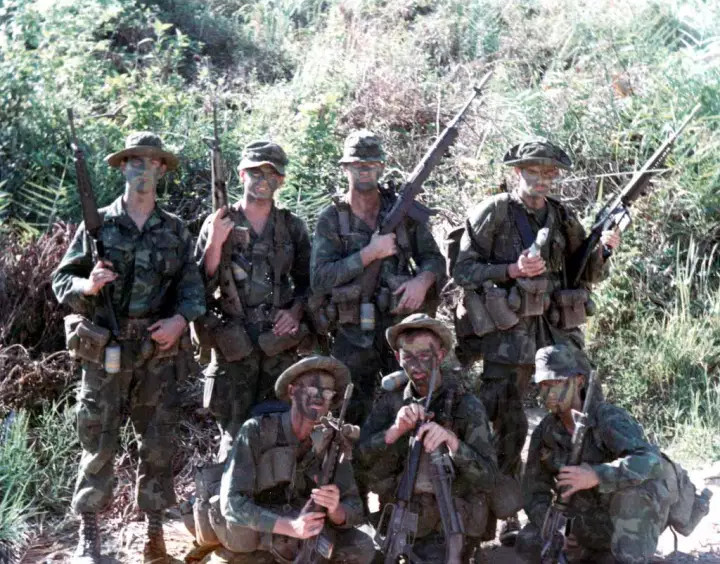
Howard’s team established an observation post and began monitoring enemy movements, as well as calling in artillery strikes on them. North Vietnamese forces, supported by local guerillas, subsequently determined the Marines’ general position and sent a force of reportedly between 200 and 300 personnel to flush them out. The reconnaissance platoon repeatedly beat back attacks from this battalion-sized enemy force, with the help of air support, while awaiting extraction, with the fighting said to have been close enough at times for both sides to exchange taunts.
By the time helicopters arrived to extract the Marines, five members of the reconnaissance team were killed and all but one were wounded. However, differing accounts estimate they had inflicted between 40 and 200 casualties on the enemy in the process. Howard was seriously injured by an enemy grenade, but continued to exercise control over his unit and call in airstrikes, actions that led to him receiving the Medal of Honor.

“Moving from position to position, he inspired his men with dynamic leadership and courageous fighting spirit until he was struck and painfully wounded by fragments from an enemy hand grenade,” the award citation reads. “Unable to move his legs and realizing that the position was becoming untenable, he distributed his ammunition to the remaining members of his platoon and skillfully directed friendly aircraft and artillery strikes with uncanny accuracy upon the enemy. … When rescue helicopters proceeded to Gunnery Sergeant Howard’s position, he directed them away from his badly mauled force and called additional air strikes and directed devastating small arms fire on the enemy thus making the landing zone secure as possible.”
Other members of Howard’s platoon also received various awards and it became the single most decorated unit of the Vietnam War. Howard himself attained a near-legendary status for his role in the Battle of Hill 488.
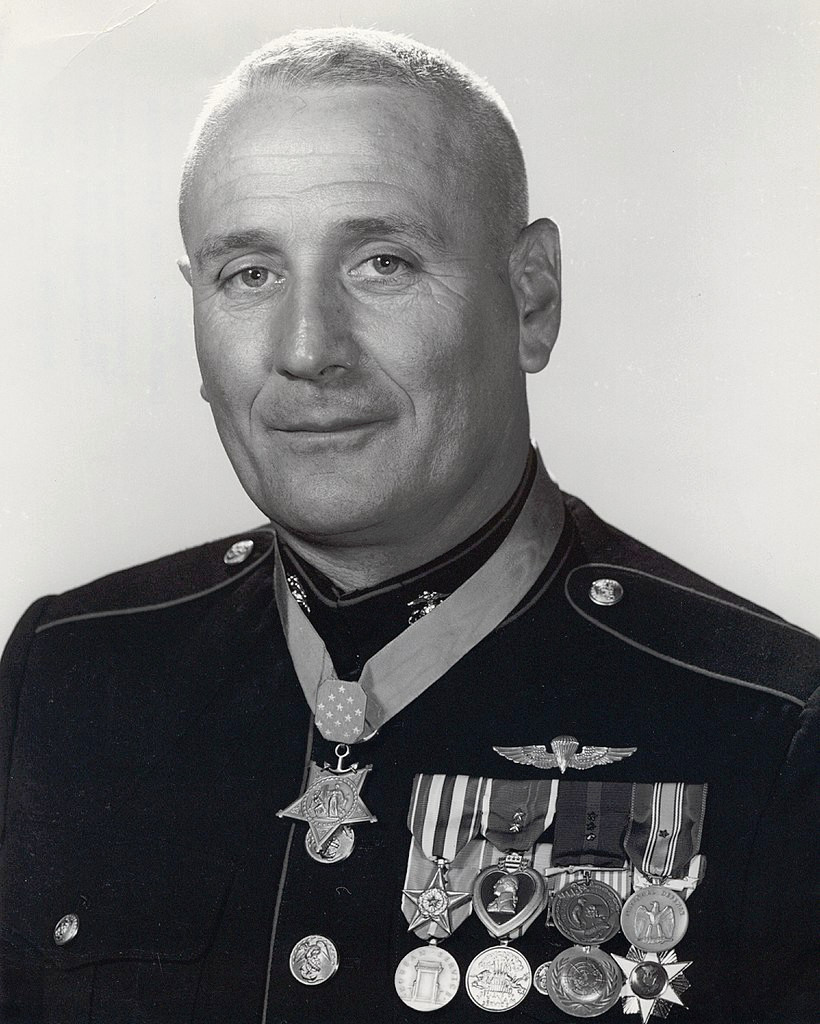
Howard continued to serve with the Marines until he retired in 1977, having attained the rank of First Sergeant. He died in 1993. The decision was subsequently made to name DDG-83 after him and the ship was officially christened in 1999, two years ahead of its formal delivery to the Navy.
As already noted, while the current USS Howard is formally named after Jimmie E. Howard, it also carries history and heritage from the last ship of that name in Navy service, a Wickes class destroyer that was commissioned shortly after the end of World War I. That vessel was named after a different Howard, Charles W., who served in the Navy during the Civil War and died on the USS New Ironsides when it was attacked by a Confederate Navy torpedo boat in 1863. That Howard had been mortally wounded while ordering sentries on the deck to fire at the incoming enemy vessel.
The Wickes class Howard was converted into a high-speed minesweeper in 1940, but was quickly sent into action as a convoy escort in the Atlantic after the United States entered World War II. The destroyer also supported the Allied invasion of North Africa in 1942.
In 1943, that Howard was transferred to the Pacific Theater, where it supported various island-hopping campaigns, including the invasions of the Marianas and the Philippines. By June 1945, however, the vessel, then 25 years old, had been pulled from frontline operations and assigned to escort duty in rear areas. After World War II ended, the ship was decommissioned and scrapped. In addition to the dragon, an array of six stars at the top of the current Howard‘s coat of arms also “allude to the previous USS Howard‘s World War II battles,” according to TIOH, though it doesn’t name any of the specific battles in question.
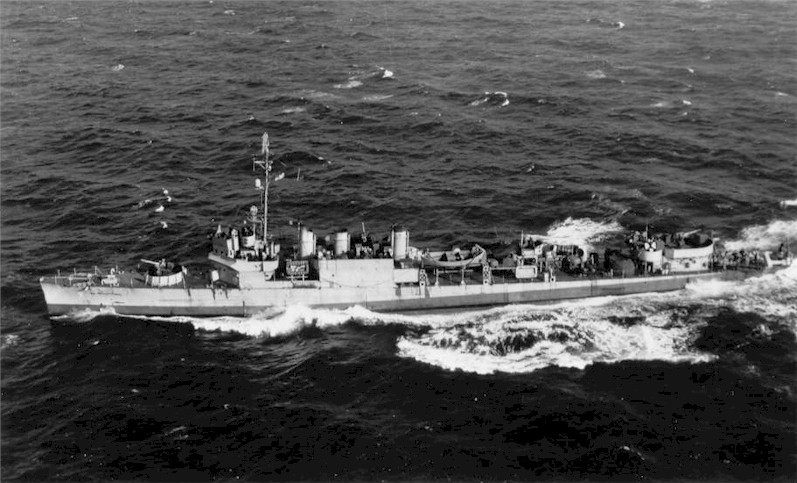
In the Arleigh Burke class USS Howard‘s two decades or so of service, it had primarily operated in the Pacific, including as part of Carrier Strike Group 11, which presently has the supercarrier USS Nimitz as its flagship. The destroyer has taken part in numerous exercises, including iterations of the biennial Rim of the Pacific (RIMPAC) exercise and annual Cooperation Afloat Readiness and Training (CARAT) engagements across southeast Asia. It has also supported humanitarian relief missions in the Pacific region.
Most notably, in 2008, Howard was among the American warships that responded to the hijacking of the MV Faina off the coast of the Horn of Africa. This turned out to be a more complex situation as the Belize-flagged cargo ship, operated by a company headquartered in Ukraine and owned by a firm based in Panama, was carrying a load of T-72 tanks and other weapons and ammunition. In addition, the cargo was ostensibly bound for Kenya, but later turned out to have actually been headed for South Sudan.

The crew attempted to, but failed to overpower the hijackers, and the ship was ultimately released after a ransom was paid. It then proceeded to Mombasa in Kenya, where it offloaded its cargo, which was then eventually sent overland to South Sudan.

The USS Howard has now left San Diego again, flying a flag that reflects the storied history associated with its name and, in line with its motto, its crew’s readiness to pursue “victory” in whatever tasks they are assigned.
Contact the author: joe@thedrive.com
